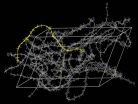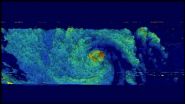(Press-News.org) Researchers from the University of Cambridge have identified a class of low-cost, easily-processed semiconducting polymers which, despite their seemingly disorganised internal structure, can transport electrons as efficiently as expensive crystalline inorganic semiconductors.
In this new polymer, about 70% of the electrons are free to travel, whereas in conventional polymers that number can be less than 50%. The materials approach intrinsic disorder-free limits, which would enable faster, more efficient flexible electronics and displays. The results are published today (5 November) in the journal Nature.
For years, researchers have been searching for semiconducting polymers that can be solution processed and printed – which makes them much cheaper – but also retain well-defined electronic properties. These materials are used in printed electronic circuits, large-area solar cells and flexible LED displays.
However, a major problem with these materials – especially after they go through a messy wet coating, fast-drying printing process – is that they have an internal structure more like a bowl of spaghetti than the beautifully ordered crystal lattice found in most electronic or optoelectronic devices.
These nooks and crannies normally lead to poorer performance, as they make ideal places for the electrons which carry charge throughout the structure to become trapped and slowed down.
Polymer molecules consist of at least one long backbone chain, with shorter chains at the sides. It is these side chains which make conjugated polymers easy to process, but they also increase the amount of disorder, leading to more trapped electrons and poorer performance.
Now, the Cambridge researchers have discovered a class of conjugated polymers that are extremely tolerant to any form of disorder that is introduced by the side chains. "What is most surprising about these materials is that they appear amorphous, that is very disordered, at the microstructural level, while at the electronic level they allow electrons to move nearly as freely as in crystalline inorganic semiconductors," said Mark Nikolka, a PhD student at the University's Cavendish Laboratory and one of the lead authors of the study .
Using a combination of electrical and optical measurements combined with molecular simulations, the team of researchers led by Professor Henning Sirringhaus were able to measure that, electronically, the materials are approaching disorder-free limits and that every molecular unit along the polymer chain is able to participate in the transport of charges.
"These materials resemble tiny ribbons of graphene in which the electrons can zoom fast along the length of the polymer backbone, although not yet as fast as in graphene," said Dr Deepak Venkateshvaran, the paper's other lead author. "What makes them better than graphene, however, is they are much easier to process, and therefore much cheaper."
The researchers plan to use these results to provide molecular design guidelines for a wider class of disorder-free conjugated polymers, which could open up a new range of flexible electronic applications. For example, these materials might be suitable for the electronics that will be needed to make the colour and video displays that are used in smartphones and tablets more lightweight, flexible and robust.
INFORMATION:
This research was funded by the Engineering and Physical Sciences Research Council (EPSRC) and Innovate UK.
For more information, contact:
Sarah Collins, Office of Communications
University of Cambridge
Tel: +44 (0)1223 765542, Mob: +44 (0)7525 337458
Email: sarah.collins@admin.cam.ac.uk
Notes for editors:
1. The paper, 'Approaching disorder-free transport in high-mobility conjugated polymers' is published in the journal Nature. DOI: 10.1038/nature13854.
CHICAGO (November 5, 2014) – When wildfire and people intersect, it is often in the wildland-urban interface, or WUI, a geography where homes, roads and trails intermix with fire-prone vegetation. In an article published Thursday in the journal Nature, U.S. Forest Service scientist Sarah McCaffrey and her colleagues advocate for an approach to wildfire management that reflects ecological science as well as research on the human dimensions of wildfire and fire management.
"Learning to Coexist with Wildfire," a research review led by the University of California-Berkley, ...
PHILADELPHIA –A diagnosis of septic shock was once a near death sentence. At best, survivors suffered a substantially reduced quality of life.
Penn Medicine researchers have now shown that while most patients now survive a hospital stay for septic shock, 23 percent will return to the hospital within 30 days, many with another life-threatening condition -- a rate substantially higher than the normal readmission rate at a large academic medical center. The findings are published in the new issue of Critical Care Medicine.
"Half of patients diagnosed with sepsis ...
November 5, 2014 – Insomnia is a "prevalent and persistent" problem for patients in the early phases of recovery from the disease of addiction—and may lead to an increased risk of relapse, according to a report in the November/December Journal of Addiction Medicine, the official journal of the American Society of Addiction Medicine. The journal is published by Lippincott Williams & Wilkins, a part of Wolters Kluwer Health.
"Treating sleep disturbance in early recovery may have considerable impact on maintenance of sobriety and quality of life," according ...
Despite great advances in understanding how the human brain works, psychiatric conditions, neurodegenerative disorders, and brain injuries are on the rise. Progress in the development of new diagnostic and treatment approaches appears to have stalled. In a special issue of the Cell Press journal Neuron, experts look at the challenges associated with "translational neuroscience," or efforts to bring advances in the lab to the patients who need them.
"A variety of global impact studies have identified brain disorders as a leading contributor to disabilities and morbidity ...
DENVER – A risk stratification model based on lymph node characteristics confirms with a high level of confidence the true lack of lung cancer in lymph nodes adequately sampled with endobronchial ultrasound-guided transbronchial needle aspiration and classified as negative.
Lung cancer treatment and prognosis is critically dependent on accurate staging that takes into account the extent to which cancer has spread from the primary lung tumor to other locations. Examination of lymph nodes containing lung cancer cells that have spread can be done by surgical removal, ...
Stanford University School of Medicine scientists have found a new way to forecast which patients with age-related macular degeneration are likely to suffer from the most debilitating form of the disease.
The new method predicts, on a personalized basis, which patients' AMD would, if untreated, probably make them blind, and roughly when this would occur. Simply by crunching imaging data that is already commonly collected in eye doctors' offices, ophthalmologists could make smarter decisions about when to schedule an individual patient's next office visit in order to optimize ...
Hurricane Vance was a hurricane on Nov. 4 when the Tropical Rainfall Measuring Mission or TRMM satellite and the Global Precipitation Measurement (GPM) mission satellite passed overhead and measured its rainfall from space. TRMM and GPM revealed areas of heavy rain within the storm before it weakened to a depression and made landfall on Nov. 5.
The TRMM satellite flew over hurricane Vance on Nov. 4 at 0953 UTC (4:53 a.m. EST). Rainfall derived from TRMM's Microwave Imager (TMI) data collected were overlaid on a 1000 UTC (5 a.m. EST) image from NOAA's GOES-West satellite ...
Typhoon Nuri continued moving in a northeasterly direction passing the island of Iwo To, Japan when NASA's Aqua satellite passed overhead.
The Moderate Resolution Imaging Spectroradiometer or MODIS instrument that flies aboard NASA's Aqua satellite captured a visible picture of Typhoon Nuri on Nov. 5 at 4:10 UTC (11:10 p.m. EST, Nov. 4).
At 1002 UTC (5:02 a.m. EST) a microwave image captured from NASA/JAXA's Tropical Rainfall Measuring Mission or TRMM satellite showed that the low-level center of circulation was beginning to weaken. The strongest thunderstorms had become ...
DENVER – Pretreatment interstitial lung disease (ILD) is a significant risk factor for developing symptomatic and severe radiation pneumonitis in stage I non-small cell lung cancer (NSCLC) patients treated with stereotactic body radiation therapy (SBRT) alone.
ILD is a group of diseases that cause scarring and stiffing of the tissue and space around the air sacs in the lungs, which results in diminished gas exchange. The incidence of ILD among lung cancer patients is higher than in the general population as tobacco smoking is a common risk factor for both. Some ...
CLEVELAND—Artificial platelet mimics developed by a research team from Case Western Reserve University and University of California, Santa Barbara, are able to halt bleeding in mouse models 65 percent faster than nature can on its own.
For the first time, the researchers have been able to integratively mimic the shape, size, flexibility and surface chemistry of real blood platelets on albumin-based particle platforms. The researchers believe these four design factors together are important in inducing clots to form faster selectively at vascular injury sites while ...




